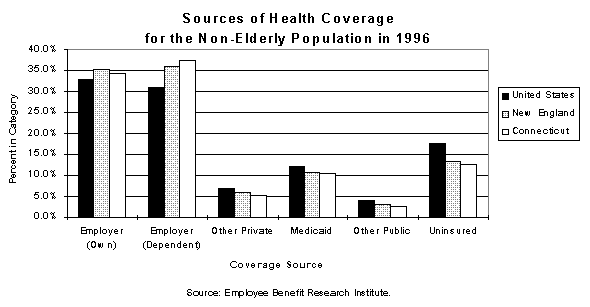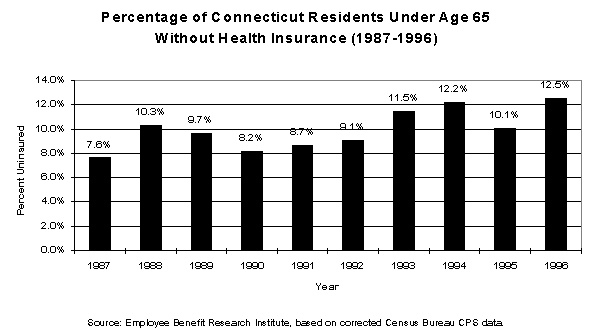
HEALTH INSURANCE IN CONNECTICUT RECENT TRENDS
Health insurance coverage is an important indicator of social and economic well-being, both for individual families and the state as a whole. While the particular estimates vary -- depending on the methodology used -- there has been a general trend upward in the percentage of Connecticut residents who lack health insurance.
Sources of Health Insurance Coverage
Virtually all Americans who lack health insurance are under age 65 because Medicare provides
coverage for nearly all elderly citizens, as well as the most severely disabled. In Connecticut, the
vast majority of non-elderly residents -- 72 percent -- obtain health coverage through an employer,
either their own or as a dependent. Another 5 percent purchase coverage for themselves directly
from insurance companies. Approximately 13 percent of the population receives coverage through
a public program, the largest of which is Medicaid. Lastly, 12.5 percent of Connecticut's non-elderly
residents are uninsured.(1)

As illustrated in the graph above, both Connecticut and the New England region relied more heavily on private sources of health insurance than the nation as a whole in 1996. In total, 77.1 percent of Connecticut's nonelderly population had private coverage, compared with the national average of 70.9 percent. New England's rate of 77 percent was almost identical to Connecticut's. Moreover, at 12.5 percent, Connecticut had a lower percentage of uninsured non-elderly residents than New England region (13.2 percent) or the nation (17.7 percent). In terms of percent uninsured, Connecticut currently ranks number 12 among states (with one being lowest and 50 being highest).
The Growth of the Uninsured in Connecticut
From 1990 to 1994, the proportion of non-elderly residents without health insurance increased from
8.2 percent to 12.2 percent. This trend mirrored Connecticut's economic fortunes through the
recession -- a steady increase in the uninsured population as the economy struggled toward recovery.
The state lost jobs in sectors that traditionally included health benefits -- defense, manufacturing and
insurance, for instance -- while it gained service sector jobs that are less likely to provide coverage.

In 1995, however, as the state's economy improved, the uninsured population decreased to 10.1 percent. While this still represented 289,000 residents, including about 80,000 children, policy makers hoped that this was the beginning of a new downward trend. Unfortunately, the new trend has not materialized. In 1996, the uninsured population appeared to increase again -- to 12.5 percent, or about 360,000 residents. According to Census Bureau estimates, children under age 18 represented about 108,000 of the uninsured; the rest -- about 252,000 -- were adults.
Data Limitations
Unfortunately, state-level survey data on the uninsured can be volatile from year to year. The Census
figures are based on data from the Bureau's March Current Population Survey (CPS). Each month
the Census Bureau conducts surveys on various demographic and socioeconomic topics and about
60,000 households are surveyed nationwide. The annual March survey includes questions about
health insurance coverage. While this is the best source of data available on the uninsured, there are
some inherent limitations. The most significant limitation for Connecticut is the relatively small
sample size.
Alternative Estimates Using Pooled CPS Data
Another method of estimating the uninsured is to merge several year's worth of CPS data to get a
more accurate picture of what is happening in a particular state. The Center on Budget and Policy
Priorities (CBPP) recently conducted such an analysis for Connecticut using data from the 1995-1997 March Current Population Surveys, which cover calender years 1994-1996.
Using this method, CBPP estimates that about 11.8 percent of Connecticut adult residents between the ages of 18 and 64 are uninsured (with a range of 10.9 percent to 12.7 percent). This represents a midpoint estimate of 232,000 uninsured adults, with a low estimate of about 214,000 to a high estimate of 250,000.
In 1997, CBPP also conducted an analysis of Connecticut's uninsured children for the Children's Health Council. The analysis used CPS data (covering calendar years 1992-1996) to provide a five-year average of uninsured residents under age 18. This produced an estimate of approximately 74,000 uninsured children.
Who are the Uninsured?
Single year national-level CPS data is more reliable and can provide a general demographic
description of the uninsured population. The Employee Benefit Research Institute (EBRI) recently
completed this type of analysis for 1996. (2) In addition, EBRI produced a fact sheet that highlights
characteristics of the uninsured for each New England state.(3) A summary of the key findings of these two publications follow. A more dated state-level analysis for Connecticut also exists, covering
1990-1992.(4) Significantly, the findings are very consistent with EBRI's more recent data.
Work Status
One of the most striking characteristics of the uninsured population is the prevalence of working
families. Nationally, 85 percent of the uninsured lived in families headed by workers in 1996.
Conversely, only 15 percent of the uninsured were in families headed by a person that did not work.
Between 1990-1992, over eight in 10 of Connecticut's uninsured lived in working families. Over 70
percent of the state's uninsured lived in families headed by a full-time worker; 15 percent lived in
families headed by a part-time worker.
Firm Size
Those who work for small firms and the self-employed are disproportionately represented among
the uninsured, while large firms are much more likely to offer health benefits. In 1996, nearly half
of the nation's uninsured workers (48 percent) worked for private-sector firms with fewer than 25
employees or were self-employed, compared with 17.5 percent of all workers. In addition, 33
percent of those who work for firms with fewer than 10 employees were uninsured, compared with
11.9 percent of those who work for firms that employ 1,000 or more workers. Among Connecticut
workers in firms with 1,000 or more employees, 65.2 percent had coverage in their own name in
1996, compared with 33.3 percent of workers in firms with fewer than 10 employees.
Industry
Workers in certain industries are more likely to be uninsured than others. Nationally, these include
agriculture, construction, retail trade, personal services, or business services. Public sector
employees and those who work in mining; manufacturing; finance, insurance and real estate; and
transportation, communications and utilities are the most likely to have employer-based coverage.
In Connecticut, workers in finance, insurance and real estate had the lowest uninsured rate at less
than 1 percent, followed by government workers at 2.4 percent. Connecticut workers with the
highest uninsured rates include those in construction (33 percent) and business and repair services
(21.6 percent).
Income
Income level is another important determinant of coverage status. Low income families are
disproportionately represented among the uninsured. In general, the higher one's income, the more
likely one is to have health insurance. Nationally, 7.4 percent of those in families with incomes of
$50,000 or more were uninsured in 1996. By contrast, 44.6 percent of the uninsured lived in families
that earned less than $20,000 a year.
In Connecticut, nearly 20 percent of children in families living below the poverty level were uninsured in 1996. This finding is particularly disturbing because all Connecticut children in families that earn less than 185 percent of the poverty level are eligible for Medicaid coverage. At the other end of the spectrum, 4.3 percent of children in families who earn 400 percent of the poverty level or more were uninsured.
Family Type
In 1996, a higher proportion of singles were uninsured compared to their married counterparts.
Nationally, 28 percent of single individuals and 20.6 percent in single-parent families were
uninsured. In contrast, 13.4 percent of married couples with children and 16 percent of couples
without children were uninsured. Overall, married couples tend to have higher incomes, especially
if both adults are working. In addition, if both are in the workforce, there is a higher probability that
the family has access to employer-based coverage. These national findings are consistent with
Connecticut data from 1990-1992.
Age
Nationally, among those ages 18-64, individuals between the ages of 45-54 were less likely to be
uninsured (13.7 percent) than any other group. By contrast, young adults aged 21-24 were the most
likely to be uninsured (32.8 percent). Many in this age group are no longer covered by their parents'
insurance policies and may not yet be established in the workforce. Among those in the 55-64 age
group, those still in the workforce were less likely to lack health insurance (11.5 percent), compared
with their retired counterparts (16.7 percent).
Policy Implications: Why Insurance Matters
For individual families -- and the state as a whole -- lack of health insurance continues to be a serious
problem. From a health perspective, the uninsured receive significantly less care and are treated in
less appropriate settings. Research has shown the uninsured visit the doctor less frequently, use
more emergency room care and are more likely to be hospitalized for chronic conditions that could
better be controlled with reliable access to physician services. More importantly, lack of health
insurance has been linked to a number of adverse health outcomes including an increased risk of
mortality.(5)
Lack of insurance affects everyone, however, not just the uninsured. When an uninsured person goes to a hospital, a clinic, or an emergency room -- and cannot pay the full cost -- the bill is passed on to those who do pay. This practice is known as cost-shifting and it results in higher premiums for those who are covered by insurance and higher taxes to cover the cost of public programs. Therefore, one way or another, society as a whole pays the price for having an uninsured population.